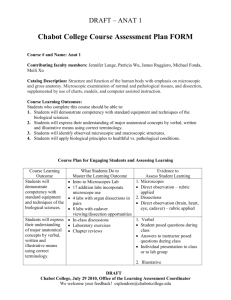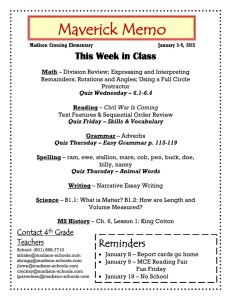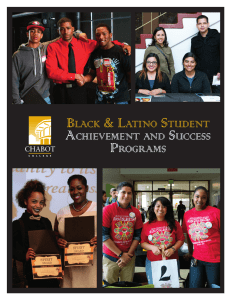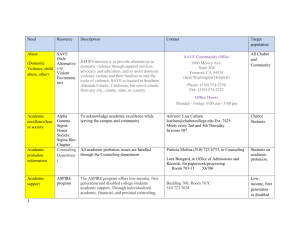Bloom`s taxonomy for the cognitive realm with outcomes and sample
advertisement
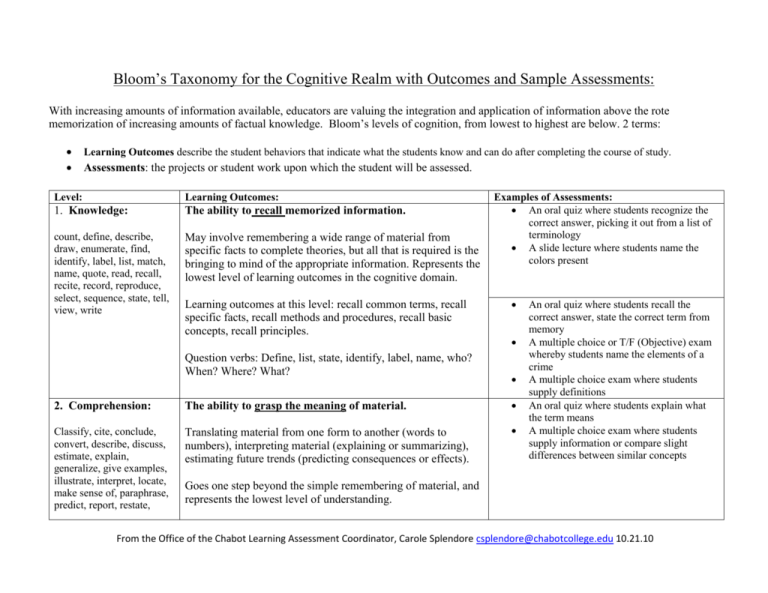
Bloom’s Taxonomy for the Cognitive Realm with Outcomes and Sample Assessments: With increasing amounts of information available, educators are valuing the integration and application of information above the rote memorization of increasing amounts of factual knowledge. Bloom’s levels of cognition, from lowest to highest are below. 2 terms: Learning Outcomes describe the student behaviors that indicate what the students know and can do after completing the course of study. Assessments: the projects or student work upon which the student will be assessed. Level: Learning Outcomes: 1. Knowledge: The ability to recall memorized information. count, define, describe, draw, enumerate, find, identify, label, list, match, name, quote, read, recall, recite, record, reproduce, select, sequence, state, tell, view, write May involve remembering a wide range of material from specific facts to complete theories, but all that is required is the bringing to mind of the appropriate information. Represents the lowest level of learning outcomes in the cognitive domain. Learning outcomes at this level: recall common terms, recall specific facts, recall methods and procedures, recall basic concepts, recall principles. Question verbs: Define, list, state, identify, label, name, who? When? Where? What? Examples of Assessments: An oral quiz where students recognize the correct answer, picking it out from a list of terminology A slide lecture where students name the colors present 2. Comprehension: The ability to grasp the meaning of material. Classify, cite, conclude, convert, describe, discuss, estimate, explain, generalize, give examples, illustrate, interpret, locate, make sense of, paraphrase, predict, report, restate, Translating material from one form to another (words to numbers), interpreting material (explaining or summarizing), estimating future trends (predicting consequences or effects). An oral quiz where students recall the correct answer, state the correct term from memory A multiple choice or T/F (Objective) exam whereby students name the elements of a crime A multiple choice exam where students supply definitions An oral quiz where students explain what the term means A multiple choice exam where students supply information or compare slight differences between similar concepts Goes one step beyond the simple remembering of material, and represents the lowest level of understanding. From the Office of the Chabot Learning Assessment Coordinator, Carole Splendore csplendore@chabotcollege.edu 10.21.10 review, summarize, trace, understand Learning outcomes at this level: understand facts and principles, interpret verbal material, interpret charts and graphs, translate verbal material to mathematical formulae, estimate the future consequences implied in data, justify methods and procedures. Question verbs: Explain, predict, interpret, infer, summarize, convert, translate, give example, account for, paraphrase x? 3. Application: act, administer, articulate, assess, change, chart, choose, collect, compute, construct, contribute, control, demonstrate, determine, develop, discover, dramatize, draw, establish, extend, imitate, implement, interview, include, inform, instruct, paint, participate, predict, prepare, produce, provide, relate, report, select, show, solve, transfer, use, utilize 4. Analysis: The ability to use learned material in new and concrete situations. Applying rules, methods, concepts, principles, laws, and theories. Learning outcomes in this area require a higher level of understanding than those under comprehension. Learning outcomes at this level: apply concepts and principles to new situations, apply laws and theories to practical situations, solve mathematical problems, construct graphs and charts, demonstrate the correct usage of a method or procedure. An oral quiz where, when given two terms, students explain how the concepts are related to each other or the whole A quiz where students name the key concepts from a video that was presented, in an oral application whereby they are simulating business scenarios Balance chemical equations A multiple choice exam where students apply Miranda rights to a fact pattern Question verbs: How could x be used to y? How would you show, make use of, modify, demonstrate, solve, or apply x to conditions y? The ability to break down material into its component parts. break down, characterize, classify, compare, contrast, correlate, debate, deduce, diagram, differentiate, discriminate, distinguish, Identifying parts, analysis of relationships between parts, recognition of the organizational principles involved. A essay or multiple choice exam whereby students compare and contrast two different theories regarding the atom A multiple choice exam where students apply Miranda rights to a fact pattern while analyzing the relevancy of the facts It is possible an analysis is necessary before From the Office of the Chabot Learning Assessment Coordinator, Carole Splendore csplendore@chabotcollege.edu 10.21.10 examine, focus, illustrate, infer, limit, outline, point out, prioritize, recognize, research, relate, separate, subdivide Learning outcomes here represent a higher intellectual level than comprehension and application because they require an understanding of both the content and the structural form of the material. Learning outcomes at this level: recognize unstated assumptions, recognizes logical fallacies in reasoning, distinguish between facts and inferences, evaluate the relevancy of data, analyze the organizational structure of a work (art, music, writing). Question verbs: Differentiate, compare / contrast, distinguish x from y, how does x affect or relate to y? Why? how? What piece of x is missing / needed? 5. Synthesis: The ability to put parts together to form a new whole. adapt, anticipate, categorize, collaborate, combine, communicate, compare, compile, compose, construct, contrast, create, design, develop, devise, express, facilitate, formulate, generate, incorporate, individualize, initiate, integrate, intervene, invent, make up, model, negotiate, organize, perform, plan, pretend, produce, progress, propose, rearrange, reconstruct, reinforce, reorganize, revise, rewrite, Learning outcomes in this area stress creative behaviors, with major emphasis on the formulation of new patterns or structure. By definition, synthesis cannot be assessed with multiple-choice questions. Learning objectives could be: a production of a unique communication (theme or speech), a plan of operations (research proposal), or a set of abstract relations (scheme for classifying information). Learning objectives at this level: write a well organized paper, give a well organized speech, write a creative short story (or poem or music), propose a plan for an experiment, integrate learning from different areas into a plan for solving a problem, formulate a new scheme for classifying objects (or events, or ideas). an application, for it to be an appropriate application; with thought, as needed in business, such as if there are multiple possible solutions, but some are more appropriate than others The facts drive the analysis. How do you filter the facts into a model within the equation. Include exam questions whereby students are driven to apply critical thinking, which most likely resides at the analysis, synthesis, and evaluation levels. More than one answer is possible. an oral quiz where a student is asked, “a patient comes in the emergency room with the following symptoms:….what is wrong with them? an oral quiz where a student is asked, “a person has had a stroke in this area of the brain, what are their symptoms?” students perform a high-tech simulation whereby students identify the symptoms and identify the correct treatment, while troubleshooting. Evaluation is achieved by reviewing a video Put together a term project whereby students combine software elements and geographical facts and concepts previously learned, to address problems such as where to locate a new shopping center: graphs, maps, tables of data A group project where students determine From the Office of the Chabot Learning Assessment Coordinator, Carole Splendore csplendore@chabotcollege.edu 10.21.10 structure, substitute, validate Question verbs: Design, construct, develop, formulate, imagine, create, change, write a short story and label the following elements: 5. Evaluation: appraise, argue, assess, choose, compare and contrast, conclude, criticize, critique, decide, defend, evaluate, interpret, judge, justify, predict, prioritize, prove, rank, rate, reframe, select, support The ability to judge the value of material (statement, novel, poem, research report) for a given purpose. The judgments are to be based on definite criteria, which may be internal (organization) or external (relevance to the purpose). The student may determine the criteria or be given them. Learning outcomes in this area are highest in the cognitive hierarchy because they contain elements of all the other categories, plus conscious value judgments based on clearly defined criteria. Learning outcomes at this level: judge the logical consistency of written material, judge the adequacy with which conclusions are supported by data, judge the value of a work (art, music, writing) by the use of internal criteria, judge the value of a work (art, music, writing) by use of external standards of excellence. Question verbs: Justify, appraise, evaluate, judge x according to and create an original artwork presentations whereby students evaluate the relationships between concepts in organic chemistry, and their uses Allow the course to sacrifice some content, and focus more on the deeper messages within The lab is coordinated with the lecture, whereby they apply the content to experiments which speak to the deeper themes A lab report where students identify two unknown compounds, by way of physical and stetroscopic tests Give students a business case which they analyze the benefits and disbenefits of a business that they would like to start. This is extra credit, but the ones who did the project are now helping the others, the others try it, and the class is up from 1/3rd to 2/3rd trying it. Last 1/3rd will be evaluating the work of the others. (All quizzes and homework are online, so course content is adequately covered in class.) A summary critique of someone else’s scholarly work, a video regarding the unevenness of development around the world, which they then critically assess this theory Provide good models of evaluation. They have 3-5 think pieces, which are 2 page papers wherby they provide their opinions on the basic sociological elements of crime. They get practice at evaluation, and this will be on the test. Hand out the best ones back From the Office of the Chabot Learning Assessment Coordinator, Carole Splendore csplendore@chabotcollege.edu 10.21.10 given criteria. Which option would be better/preferable to party y? to the class. Thus learning should be built throughout the semester, while the concepts at hand are fresh. Evaluation could be real-world written analysis of a defibrulator Challenge students with examples for the actual bar exam, or structure the course as it were a UC Berkeley course, From the Office of the Chabot Learning Assessment Coordinator, Carole Splendore csplendore@chabotcollege.edu 10.21.10

